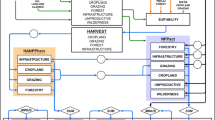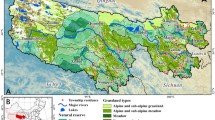Abstract
Understanding the drivers and mechanisms of the dynamics in grassland productivity is prerequisite for studying effective resource institutions and policies that can be used to govern grassland resources sustainably. We present a diagnostic analysis of the major drivers of the dynamics in grassland net primary productivity (NPP) across ecological zones on the Mongolian Plateau. We estimated a spatial panel data model for NPP (1986–2009) as a function of climatic and socioeconomic variables. Static and dynamic spatial panel models were estimated in each of the sub-regions, which were classified based on rural livelihoods and ecological models of grassland dynamics, to identify the major drivers of NPP dynamics. The statistical modeling results indicated that the major drivers of NPP dynamics vary across the six sub-regions. Grain output was the major predictor of NPP dynamics in the farming and farming-grazing zones of Inner Mongolia. Precipitation and livestock populations both had significantly positive relationships with NPP in the two grazing zones of Inner Mongolia. However, in Mongolia, livestock populations was the only significant predictor of NPP in the grazing zone with relatively stable climate, and precipitation was the only significant predictor of NPP in the grazing zone with highly variable climate. Human land-use activities and livestock management behaviors and the bidirectional causal relationships between livestock populations and NPP could explain the positive relationships between livestock population and grassland NPP. The heterogeneous drivers of NPP dynamics across space indicated the necessity of diverse resource polices and institutions for sustainable governance of grassland resources.




Similar content being viewed by others
References
ACBIMAR (2008) Annual census book of Inner Mongolia autonomous region. Inner Mongolia Press, Hohhot
ACBM (2010) Annual census book of Mongolia. National Statistical Office of Mongolia, Ulaanbaatar
Addison J, Friedel M, Brown C, Davies J, Waldon S (2012) A critical review of degradation assumptions applied to Mongolia’s Gobi Desert. Rangel J 34(2):125–137
Agrawal A (2001) Common property institutions and sustainable governance of resources. World Dev 29(10):1649–1672
Angerer BJ, Han G, Fujisaki I, Havstad K (2008) Climate change and ecosystems of Asia with emphasis on Inner Mongolia and Mongolia. Rangelands 6:46–51
Bai Y, Wu J, Xing Q, Pan Q, Huang J, Yang D, Han X (2008) Primary production and rain use efficiency across a precipitation gradient on the Mongolian Plateau. Ecology 89(8):2140–2153
Benjamini Y, Hochber Y (1995) Controlling the false discovery rate: a practical and powerful approach to multiple testing. J R Stat Soc 57(1):289–300
Briske DD, Fuhlendorf SD, Smeins FE (2003) Vegetation dynamics on rangelands: a critique of the current paradigms. J Appl Ecol 40:604–614
Brown DG, Walker R, Manson S, Seto KC (2004) Modeling land cover and land use change. In: Gutman G, Janetos AC, Justice CO, Moran EF, Mustard JF, Rindfuss RR, Skole D, Turner BL II (eds) Land change science: observing, monitoring, and understanding trajectories of change on the earth’s surface. Kluwer, Norwell, pp 395–409
CIMAR (Climate dataset of Inner Mongolia Autonomous Region) (2010) Inner Mongolia Meteorology Bureau. Hohhot, China
CM (Climate dataset of Mongolia) (2010) Mongolia Meteorology Bureau. Ulaanbaatar, Mongolia
Elhorst JP (2003) Specification and estimation of spatial panel data models. Int Reg Sci Rev 26(3):244–268
Elhorst JP (2010a) Spatial panel data models. In: Fisher MM, Getis A (eds) Handbook of applied spatial analysis. Springer, New York, pp 377–407
Elhorst JP (2010b) MATLAB software for spatial panels. Presented at the IVth world conference of the spatial econometrics association, Chicago
Ellis J, Swift D (1988) Stability of African pastoral ecosystems: alternate paradigms and implications for development. J Range Manage 41(6):450–459
Fernandez-Gimenez M (1997) Landscapes, livestock, and livelihoods: social, ecological, and land-use change among the nomadic pastoralists of Mongolia. Ph.D. Dissertation. University of California, Berkeley
Fernandez-Gimenez M, Allen-Diaz B (1999) Testing a non-equilibrium model of rangeland vegetation dynamics in Mongolia. J Appl Ecol 36:871–885
Frees EW (2004) Longitudinal and panel data: analysis and applications in the social sciences. Cambridge University Press, New York
Hardin G (1968) The tragedy of commons. Science 162:1243–1248
Ho P (2001) Rangeland degradation in north China revisited? A preliminary statistical analysis to validate non-equilibrium range ecology. J Dev Stud 37(3):99–133
Hsiao C (1986) Analysis of panel data. Cambridge University Press, New York
Humphrey C, Sneath D (1999) The end of nomadism? Society, state and the environment in Inner Asia. Duke University Press, Durham
IMIGSD (Inner Mongolian Institute of Grassland Survey and Design) (2008) Statistics of the areas of reclaimed grasslands in Inner Mongolia. Hohhot, China
IMIGSD (Inner Mongolian Institute of Grassland Survey and Design) (2011) Statistics of grassland quality change in Inner Mongolia. Hohhot, China
IOB (Institute of Botany) (2011) Statistics of grassland quality in Mongolia. Ulaanbaatar, Mongolia
Jiang G, Han X, Wu J (2006) Restoration and management of the Inner Mongolia grassland require a sustainable strategy. Ambio 35(5):269–270
Lee L, Yu J (2010) A spatial dynamic panel data model with both time and individual fixed effects. Econ Theory 26:564–597
Li W, Ali S, Zhang Q (2007) Property rights and grassland degradation: a study of the Xilingol Pasture, Inner Mongolia, China. J Environ Manage 85:461–470
Lu Y, Zhuang Q, Zhou G, Sirlin A, Mellio J, Kicklighter D (2009) Possible decline of the carbon sink in the Mongolian Plateau during the 21st century. Environ Res Lett. doi:10.1088/1748-9326/4/4/045023
NCRMSAP (National Climate Risk Management Strategy and Action Plan) (2009) Ulaanbaatar, Mongolia
Neupert R (1999) Population, nomadic-pastoralism and the environment in the Mongolian Plateau. Popul Environ 20(5):413–441
Oba G, Stenseth NC, Lusigi WJ (2000) New perspectives on sustainable grazing management in arid zones of Sub-Saharan Africa. BioScience 50(1):35–51
Olonbayar M (2010) Livelihood study of herders in Mongolia. Mongolian Society for Range Management, Ulaanbaatar
Ostrom E (1990) Governing the commons: the evolution of institutions for collective action. Cambridge University Press, New York
Ostrom E (2005) Understanding institutional diversity. Princeton University Press, Princeton
Ostrom E (2010) Beyond markets and states: polycentric governance of complex economic systems. Am Econ Rev 100:641–672
Running SW, Nemani R, Glassy JM, Thornton PE (1999) MODIS daily photosynthesis (PSN) and annual net primary production (NPP) product (MOD17): Algorithm Theoretical Basis Document. http://ntsg.umt.edu/sites/ntsg.umt.edu/files/modis/ATBD/ATBD_MOD17_v21.pdf. Accessed 7 Dec 2012
Seto KC, Kaufmann RK (2003) Modeling the drivers of urban land use change in the Pearl River Delta, China: integrating remote sensing with socioeconomic data. Land Econ 79(1):106–121
Sneath D (1998) State policy and pasture degradation in Inner Asia. Science 281:1147–1148
Upton C (2009) “Custom” and contestation: land reform in post-socialist Mongolia. World Dev 37(8):1400–1410
Waldron S, Brown C, Longworth J (2010) Grassland degradation and livelihoods in China’s western pastoral region: a framework for understanding and refining China’s recent policy responses. China Agric Econ Rev 2(3):298–318
Wang J, Brown DG, Agrawal A (2012) Sustainable governance of the Mongolian grasslands: comparing ecological and social-institutional changes in the context of climate change in Mongolia and Inner Mongolia, China, In: Chen J, Wan S, Henebry GM, Qi J, Gutman G, Sun G, Kappas M (eds) Dryland Ecosystems in East Asia: State, Changes, and Future (in press)
Wang J, Brown DG, Chen J (2013) Dynamics of net primary productivity in the Mongolian grassland (1982–2009) in response to climate variability and change (working paper)
Wehrden HV, Hanspach J, Kaczensky P, Fischer J, Wesche K (2012) Global assessment of the non-equilibrium concept in rangelands. Ecol Appl 22(2):393–399
Wilson PN, Thompson GD (1993) Common property and uncertainty: compensating coalitions by Mexico’s pastoral Ejidatarios. Econ Dev Cult Change 41(2):299–318
Yu J, De Jong R, Lee L (2008) Quasi-maximum likelihood estimators for spatial dynamic panel data with fixed effects when both n and T are large. J Econom 146:118–134
Zemmrich A, Manthey M, Zerbe S, Oyunchimeg D (2010) Driving environmental factors and the role of grazing in grassland communities: a comparative study along an altitudinal gradient in Western Mongolia. J Arid Environ 74:1271–1280
Zhang X (1992) Northern China. In: Committee on Scholarly Communication with the People’s Republic of China, National Research Council (ed) Grasslands and Grassland Science in Northern China. National Academy Press, Washington, D. C, pp 39–54
Zhang Q (2007) Impacts of double-contract responsibility system on rangeland and animal husbandry: a perspective of natural resource heterogeneity. Ph.D. Dissertation. Beijing University, Beijing
Acknowledgments
The work was conducted with financial support from the NASA Land-Cover/Land-Use Change Program.
Author information
Authors and Affiliations
Corresponding author
Rights and permissions
About this article
Cite this article
Wang, J., Brown, D.G. & Chen, J. Drivers of the dynamics in net primary productivity across ecological zones on the Mongolian Plateau. Landscape Ecol 28, 725–739 (2013). https://doi.org/10.1007/s10980-013-9865-1
Received:
Accepted:
Published:
Issue Date:
DOI: https://doi.org/10.1007/s10980-013-9865-1




